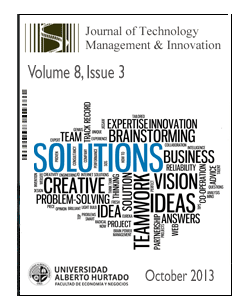University Spin-off Creation by Spanish Researchers in Agricultural Engineering.
DOI:
https://doi.org/10.4067/S0718-27242013000400014Keywords:
University Spin-off, Technology transfer, Engineering, Precision agriculture, Sustainble agricultureAbstract
This paper describes how a team of university professors and graduate students created a technology-based company (spin-off) to as a means to deliver their research findings to the agricultural sector. The spin-off company was based on the use of new methodologies, equipment, instrumentation and sensors initially developed for various research projects. Successful field tests and positive feedback from farmers initially prompted the development of the spin-off. The spin-off progress has been observed and recorded from the idea phase through the company start-up until the second round of financing (October 2007 to January 2010). Since limited time scales are commonly found in agriculture, the spin-off company provided a way to deliver timely research results to the agricultural community. Although university research results may eventually end up in the agricultural sector, in many cases this process requires a lot of bureaucracy and time. Spin-off companies can be flexible tools to transfer this knowledge and technology to the agricultural sector, as well as providing direct career opportunities for graduate students and PhD students.Downloads
References
Agüera, J. Pérez, M., Gil, J., Madueño, A. Zarco-Tejada, P. and Blanco, G. (2003). Determining spatial variability of yield and reflectance of a cotton crop in the Guadalquivir Valley. 4th European Conference on Precision Agriculture. pp. 347-349 Berlin.
Arnó, J., Bordes, X., Ribes-Dasi, M., Blanco, R., Rosell, J.R. and Esteve, J. (2005). Obtaining grape yield maps and analysis of within-field variability in Raimat (Spain). 5th European Conference on Precision Agriculture. 9-12 June, Uppsala (Sweden).
Basberg, B.L. (1987). Patents and the measurement of technological change: a survey of the literature, Research Policy, (16), 131-141.
Beraza, J.M. and Rodríguez, A. (2008) «El entorno español para la creación de nuevas empresas de base tecnológica: la actividad de I+D+i en España. Una comparación internacional», XXII Congreso Anual AEDEM, VI International Conference IABD, Salamanca.
Elfring, T. and Hulsink, W. (2001). Fighting for survival and legitimacy: Growth trajectories of high technology firms in the Netherlands. In W. During, R. Oakey and S. Kauser (Eds.). New technology-based firms in the new millennium (pp. 4–25). Oxford: Pergamon Press.
Etzkowitz, H. (2003). Research groups as “quasi-firms”: The invention of the entrepreneurial university. Research Policy, (32), 109–122.
Hulsink, W. and Elfring, T. (2003). Entrepreneurs, new technology firms and networks: Experiences from lone starters, spin-offs and incubates in the Dutch ITC Industry 1990–2000. In W. During, R. Oakey and S. Kauser (Eds.). New technology-based firms in the new millennium, vol. III. Oxford: Pergamon Press.
Hurst, E. and Lusardi, A. (2004). Liquidity Constrains, Household Wealth, and Entrepreneurship. Journal of Political Economy, 112(2). 319-47.
Life Sciences Database, (2010) http://flandersbio.be/life-sciences-database/k.u.leuven/, Accessed 7 July 2010.
Mustar, P. and M. Wright, M. (2010). Convergence or path dependency in policies for foster the creation of university spin-off firms? A comparison of France and the United Kingdom. Journal of Technology Transfer. (35), 42-65.
O’Shea, R., Allen, T., Morse, K., O’Groman, C. and Roche, F. (2007). Delineating the anatomy of an entrepreneurial university: the Massachusetts Institute of Technology experience. R&D Management (37), 1.
Perez, M., Aguera, J., Gil, J., Madueno, A. and Blanco, G. (2006). Comparative study of some vegetation indices calculated from different spectral images. World Congress Agricultural Engineering for a Better World. pp. 387-388. Bonn.
Quadrini, V. (1999). The importance of entrepreneurship for wealth concentration and mobility. Review of Income and Wealth, (45), 1-19.
Rasmussen, E. and Borch, O.J. (2006). The university and the spin-off process - A dynamic capability approach In: D. Urbano Ed., Diversity in entrepreneurship -3rd Inter-RENT Online Publication pp. 3-28. Vol. 3. (ECSB), Naples, Italy.
Rothaermel, F.T. and Thursby, M. (2005) University-incubator
firm knowledge flows: assessing their impact on incubator firm performance. Research Policy (34), 305–320.
Shane, S. (2004). Academic Entrepreneurship: University spinoffs and Wealth Creation. Edward Elgar, Cheltenham, UK.
Solé, F. (2003). Entrepreneurship y Desarrollo Regional. La Cultura y el Desarrollo endógeno. In F. Solé and R. Martinez (Eds.), Creación de empresas. Entrepreneurship (pp. 327–342). Barcelona, Spain: Universitat Autonoma de Barcelona.
Wright, M., Clarysse, B., Mustar, P. and Lockett, A. (2007). Academic entrepreneurship in Europe. Edward Elgar, Cheltenham, UK-Northampton, MA, USA.
Downloads
Published
How to Cite
Issue
Section
License
Copyright (c) 2013 Journal of Technology Management & Innovation

This work is licensed under a Creative Commons Attribution-ShareAlike 4.0 International License.







